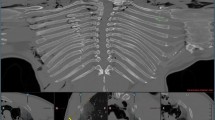Abstract
Objective
To assess a radiologist’s detection rate of rib fractures in trauma CT when reading curved planar reformats (CPRs) of the ribs compared to reading standard MPRs.
Methods
Two hundred and twenty trauma CTs (146 males, 74 females) were retrospectively subjected to a software algorithm to generate CPRs of the ribs. Patients were split into two equal groups. Sixteen patients were excluded due to insufficient segmentation, leaving 107 patients in group A and 97 patients in group B. Two radiologists independently evaluated group A using CPRs and group B using standard MPRs. Two different radiologists reviewed both groups with the inverse methods setting. Results were compared to a standard of reference created by two senior radiologists.
Results
The reference standard identified 361 rib fractures in 61 patients. Reading CPRs showed a significantly higher overall sensitivity (P < 0.001) for fracture detection than reading standard MPRs, with 80.9 % (584/722) and 71.5 % (516/722), respectively. Mean reading time was significantly shorter for CPRs (31.3 s) compared to standard MPRs (60.7 s; P < 0.001).
Conclusion
Using CPRs for the detection of rib fractures accelerates the reading of trauma patient chest CTs, while offering an increased overall sensitivity compared to conventional standard MPRs.
Key Points
• In major blunt trauma, rib fractures are diagnosed with Computed Tomography.
• Image processing can unfold all ribs into a single plane.
• Unfolded ribs can be read twice as fast as axial images.
• Unfolding the ribs allows a more accurate diagnosis of rib fractures.






Similar content being viewed by others
Abbreviations
- Standard MPRs:
-
Multi planar reformats in transverse, coronal, and sagittal orientations
- CPRs:
-
Curved planar reformats
References
Ziegler DW, Agarwal NN (1994) The morbidity and mortality of rib fractures. J Trauma 37:975–979
Livingston DH, Shogan B, John P, Lavery RF (2008) CT diagnosis of rib fractures and the prediction of acute respiratory failure. J Trauma 64:905–911
Moore EE (2004) Trauma, 5th edn. Mcgraw-Hill, New York
Townsend CM Jr, Ebea Br (2008) Sabiston textbook of surgery, 18 edn. Philadelphia
Truitt MS, Mooty RC, Amos J, Lorenzo M, Mangram A, Dunn E (2010) Out with the old, in with the new: a novel approach to treating pain associated with rib fractures. World J Surg 34:2359–2362
Shweiki E, Klena J, Wood GC, Indeck M (2001) Assessing the true risk of abdominal solid organ injury in hospitalized rib fracture patients. J Trauma 50:684–688
Simon BJ, Chu Q, Emhoff TA, Fiallo VM, Lee KF (1998) Delayed hemothorax after blunt thoracic trauma: an uncommon entity with significant morbidity. J Trauma 45:673–676
Traub M, Stevenson M, McEvoy S et al (2007) The use of chest computed tomography versus chest X-ray in patients with major blunt trauma. Injury 38:43–47
Novelline RA, Rhea JT, Rao PM, Stuk JL (1999) Helical CT in emergency radiology. Radiology 213:321–339
Harris JH Jr (2001) Reflections: emergency radiology. Radiology 218:309–316
Linsenmaier U, Krotz M, Hauser H et al (2002) Whole-body computed tomography in polytrauma: techniques and management. Eur Radiol 12:1728–1740
Wintermark M, Poletti PA, Becker CD, Schnyder P (2002) Traumatic injuries: organization and ergonomics of imaging in the emergency environment. Eur Radiol 12:959–968
Wilson EB (1927) Probable inference, the law of succession, and statistical inference. J Am Stat Assoc 22:209–212
Andriole KP, Morin RL, Arenson RL et al (2004) Addressing the coming radiology crisis-the Society for Computer Applications in Radiology transforming the radiological interpretation process (TRIP) initiative. J Digit Imaging 17:235–243
Brochu B, Beigelman-Aubry C, Goldmard JL, Raffy P, Grenier PA, Lucidarme O (2007) Computer-aided detection of lung nodules on thin collimation MDCT: impact on radiologists’ performance. J Radiol 88:573–578
Mang T, Graser A, Schima W, Maier A (2007) CT colonography: techniques, indications, findings. Eur J Radiol 61:388–399
Ringl H, Schernthaner RE, Schueller G et al (2010) The skull unfolded: a cranial CT visualization algorithm for fast and easy detection of skull fractures. Radiology 255:553–562
Ringl H, Stiassny F, Schima W et al (2013) Intracranial hematomas at a glance: advanced visualization for fast and easy detection. Radiology 267:522–530
Mang T, Kolligs FT, Schaefer C, Reiser MF, Graser A (2011) Comparison of diagnostic accuracy and interpretation times for a standard and an advanced 3D visualisation technique in CT colonography. Eur Radiol 21:653–662
Ringl H, Schernthaner R, Philipp MO et al (2009) Three-dimensional fracture visualisation of multidetector CT of the skull base in trauma patients: comparison of three reconstruction algorithms. Eur Radiol 19:2416–2424
Dachman AH, Obuchowski NA, Hoffmeister JW et al (2010) Effect of computer-aided detection for CT colonography in a multireader, multicase trial. Radiology 256:827–835
Halligan S, Mallett S, Altman DG et al (2011) Incremental benefit of computer-aided detection when used as a second and concurrent reader of CT colonographic data: multiobserver study. Radiology 258:469–476
Alkadhi H, Wildermuth S, Marincek B, Boehm T (2004) Accuracy and time efficiency for the detection of thoracic cage fractures: volume rendering compared with transverse computed tomography images. J Comput Assist Tomogr 28:378–385
Cho SH, Sung YM, Kim MS (2012) Missed rib fractures on evaluation of initial chest CT for trauma patients: pattern analysis and diagnostic value of coronal multiplanar reconstruction images with multidetector row CT. Br J Radiol 85:e845–850
Acknowledgements
The scientific guarantor of this publication is Helmut Ringl. The authors of this manuscript declare relationships with the following company: Siemens. The authors state that the software used was supplied by Siemens. Michael Weber kindly provided statistical advice for this manuscript. Institutional Review Board approval was obtained. Written informed consent was waived by the Institutional Review Board. Methodology: retrospective, diagnostic study, performed at one institution.
Author information
Authors and Affiliations
Corresponding author
Rights and permissions
About this article
Cite this article
Ringl, H., Lazar, M., Töpker, M. et al. The ribs unfolded - a CT visualization algorithm for fast detection of rib fractures: effect on sensitivity and specificity in trauma patients. Eur Radiol 25, 1865–1874 (2015). https://doi.org/10.1007/s00330-015-3598-2
Received:
Revised:
Accepted:
Published:
Issue Date:
DOI: https://doi.org/10.1007/s00330-015-3598-2




